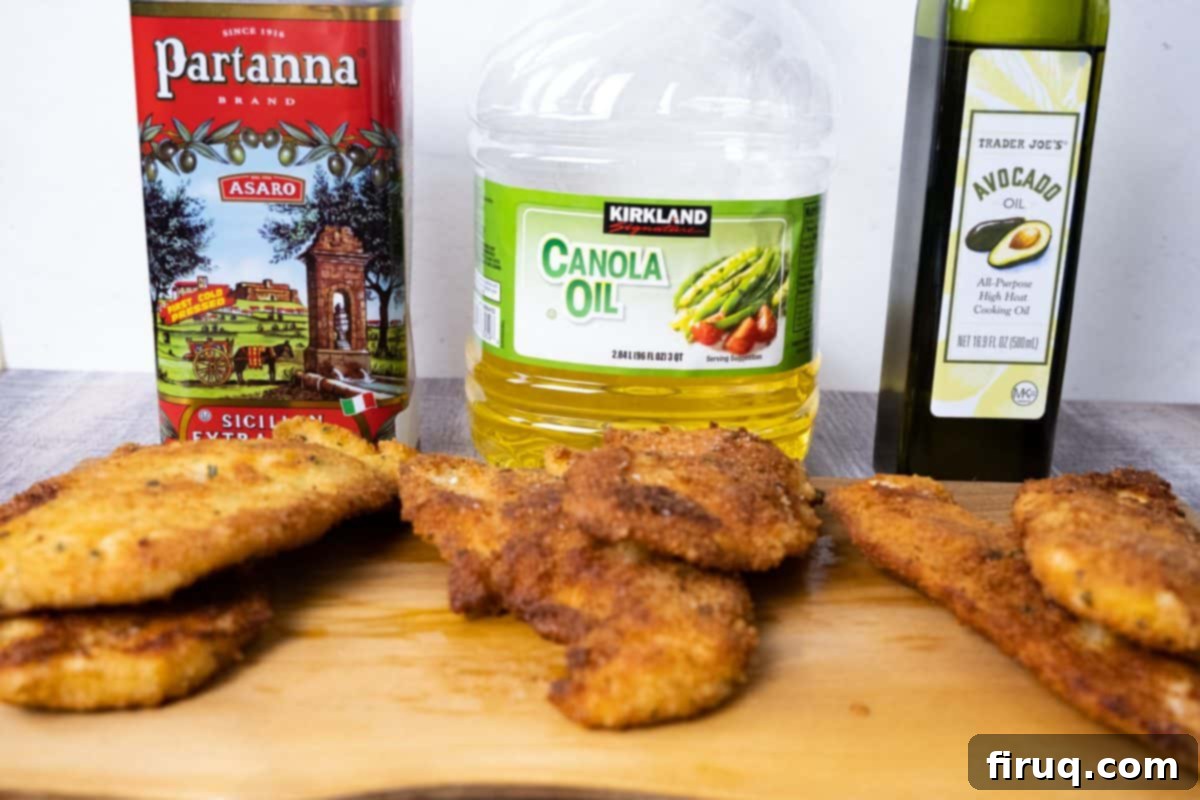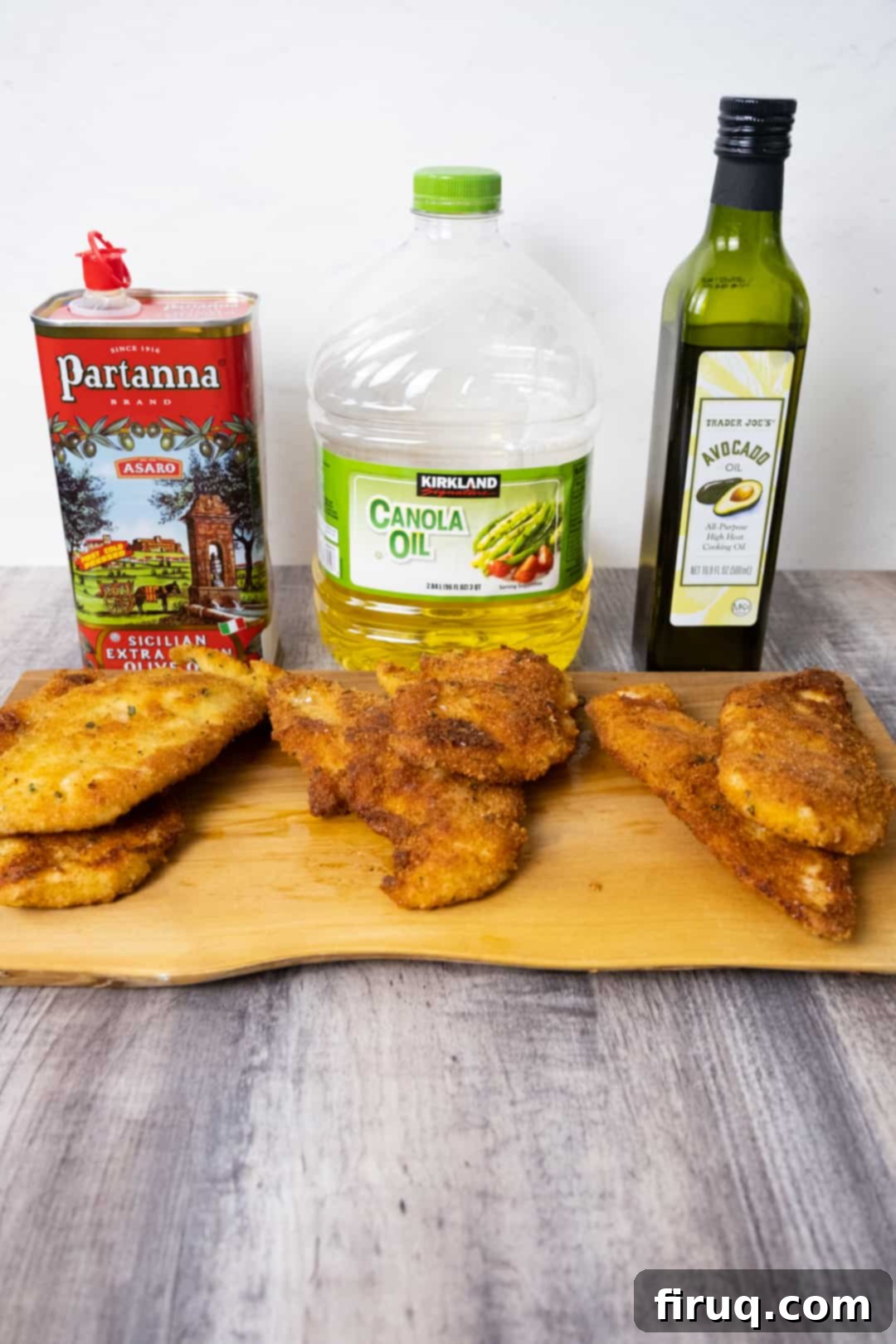The Best Oil for Frying Chicken Cutlets: A Comprehensive Guide
Choosing the perfect oil for frying chicken cutlets can feel like a culinary quest, and if you’re seeking a simple, one-word answer, you’re in for a challenge! The truth is, the “best” oil often comes down to a balance of health considerations, flavor impact, cooking performance, and personal preference. While my personal inclination leans towards frying Italian Chicken Cutlets in a high-quality extra virgin olive oil, there are compelling pros and cons to each option. This article dives deep into an experiment comparing three popular frying oils – avocado, canola, and extra virgin olive oil – to help you determine the ideal choice for creating delicious, crispy chicken cutlets in your own kitchen.
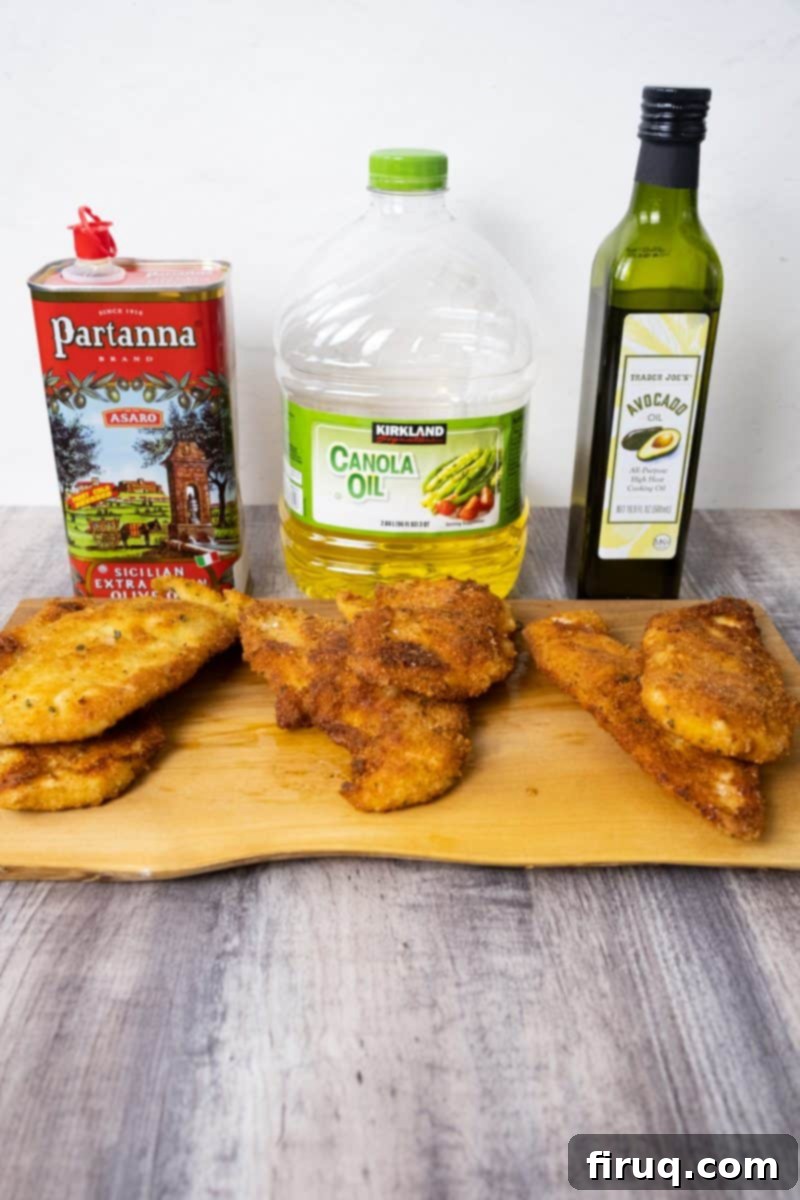
Beyond the oil, mastering chicken cutlets involves several key steps. For more insights into creating the perfect crispy cutlet, explore our detailed analysis of egg substitutes in our guide to No Egg Chicken Cutlets!
Why Your Choice of Frying Oil Matters for Chicken Cutlets
Frying isn’t just about getting food hot; it’s about achieving that desirable golden-brown crust, tender interior, and irresistible flavor. The type of oil you choose plays a critical role in all these aspects. Different oils have varying smoke points, flavor profiles, and nutritional compositions, all of which influence the final outcome of your dish. Understanding these differences is key to consistently making delicious and potentially healthier chicken cutlets.
Our Comprehensive Chicken Cutlet Oil Experiment
To truly understand which oil performs best for frying chicken cutlets, we conducted a side-by-side experiment focusing on three of the most commonly discussed and debated oils: Avocado Oil, Canola Oil, and Extra Virgin Olive Oil. These oils were selected because they represent a range of popular choices, each with its own staunch proponents and critics. It seems everyone has an opinion, often rooted in family tradition or popular discourse, but we wanted to find out what really works.
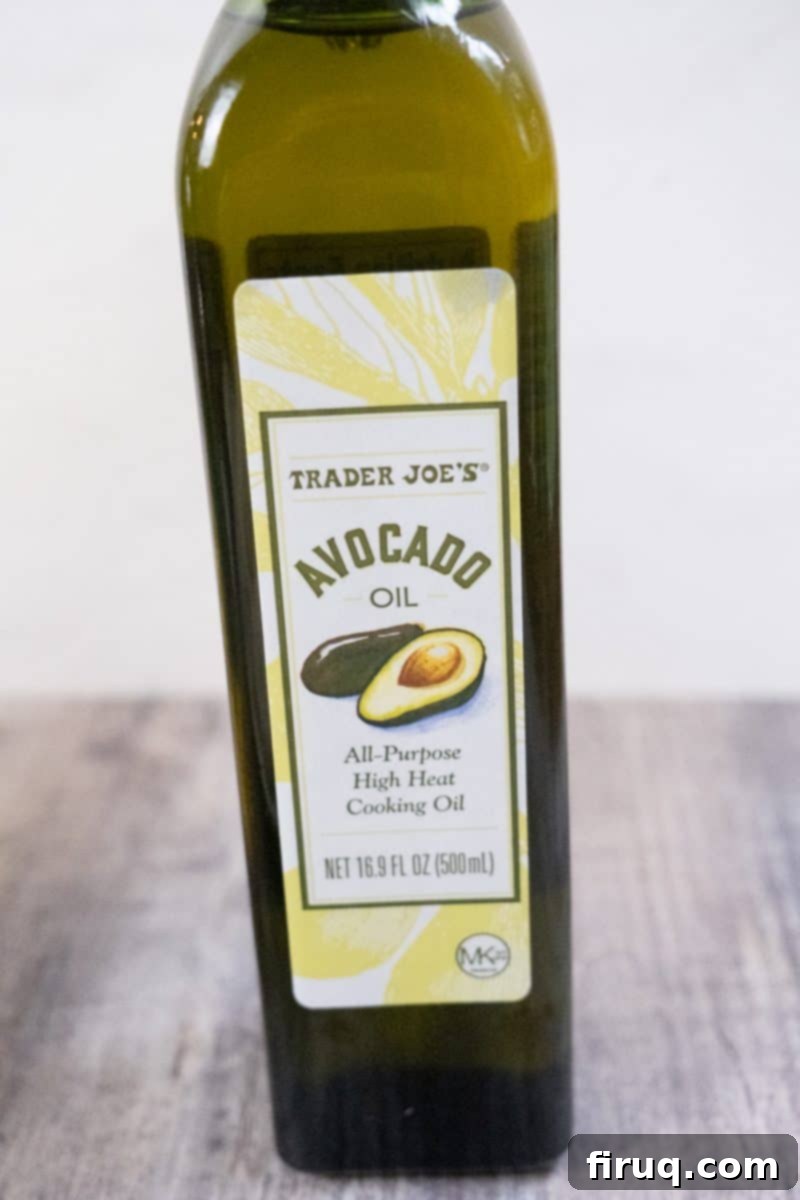
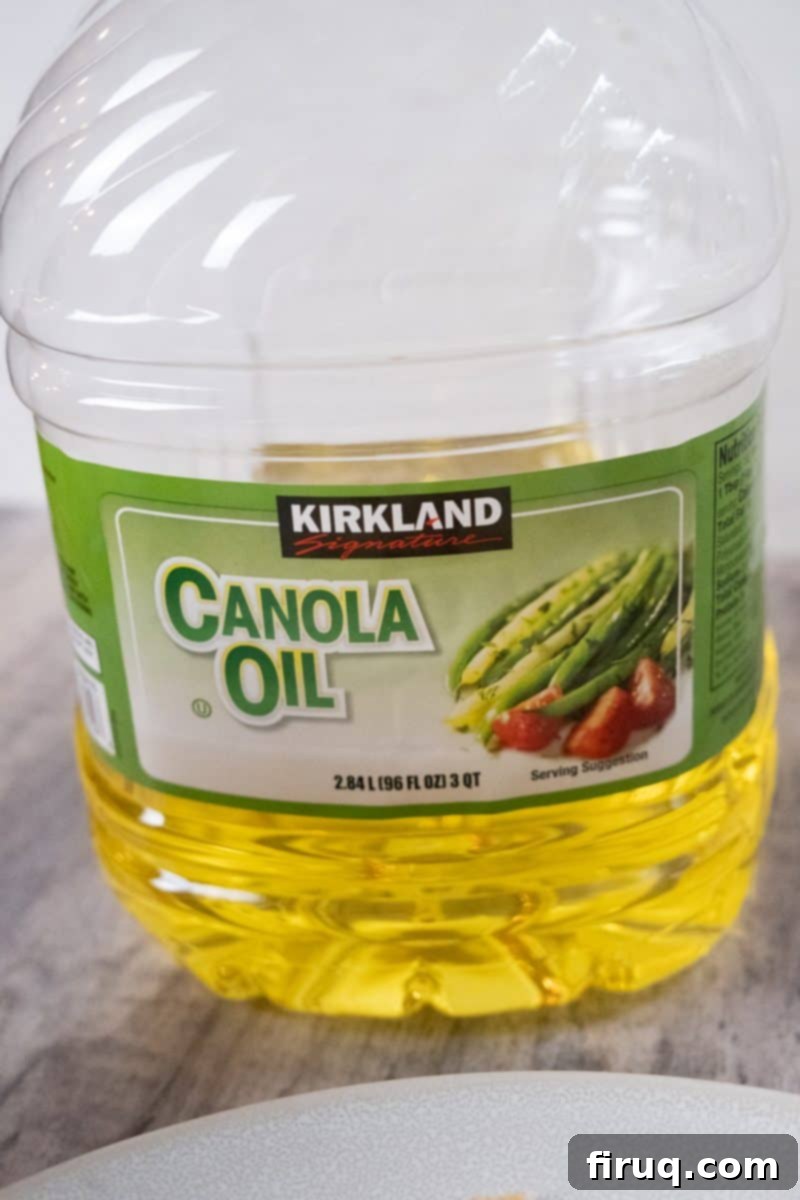
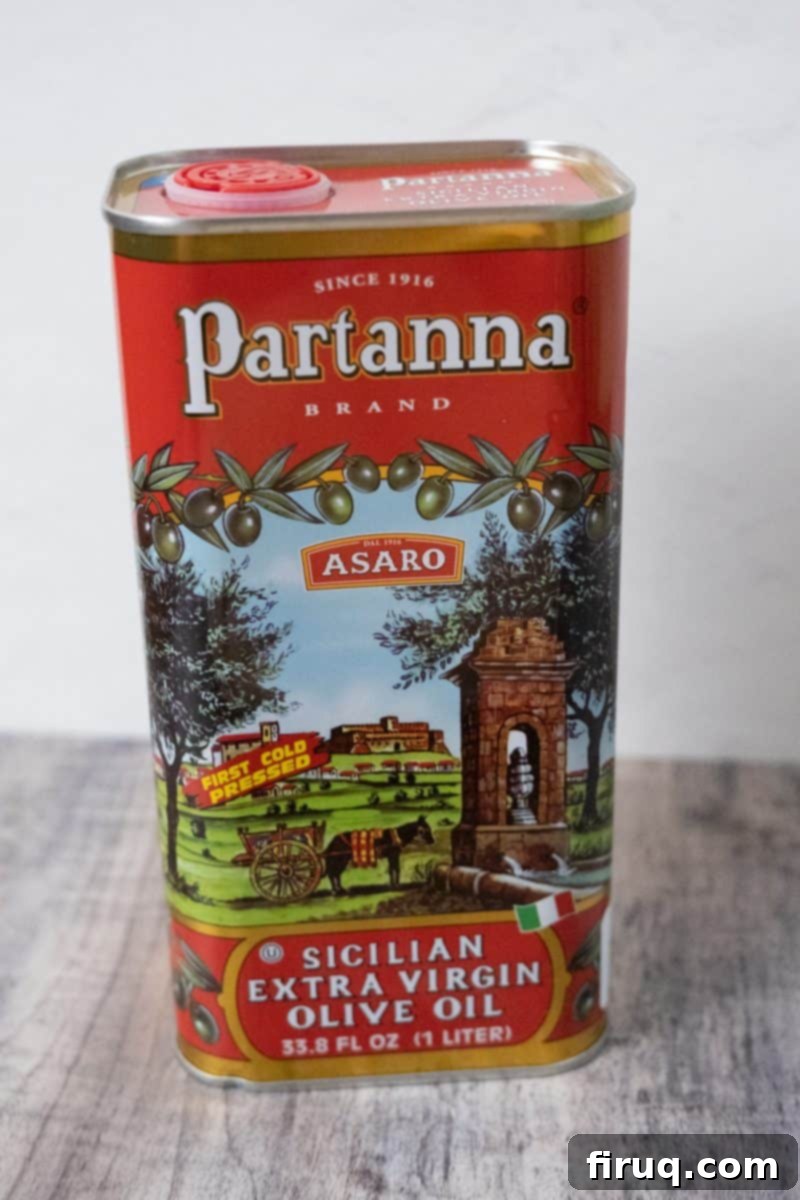
My own culinary journey with chicken cutlets has been quite varied. I grew up in a household where my mother often baked our chicken cutlets – a method that, while health-conscious, I’ve never quite been able to replicate to her standard of perfection. There’s a certain magic to how she kept them from getting mushy in the oven! On the other hand, my wife’s family always fried their cutlets in canola oil, a practice we adopted for years. However, with the launch of Always From Scratch and a renewed focus on healthy eating, I began questioning the regular consumption of highly processed oils like canola.
For this experiment, we ensured consistency across all trials. We used Trader Joe’s Avocado Oil, Kirkland Canola Oil, and Partanna Extra Virgin Olive Oil. Each cutlet was cooked to an internal temperature of 165℉. To minimize variables, all oils were given the exact same amount of time to heat up in the pan, and the pan was thoroughly cleaned between each oil test. This meticulous approach allowed us to accurately compare the performance and characteristics of each oil without confounding factors.
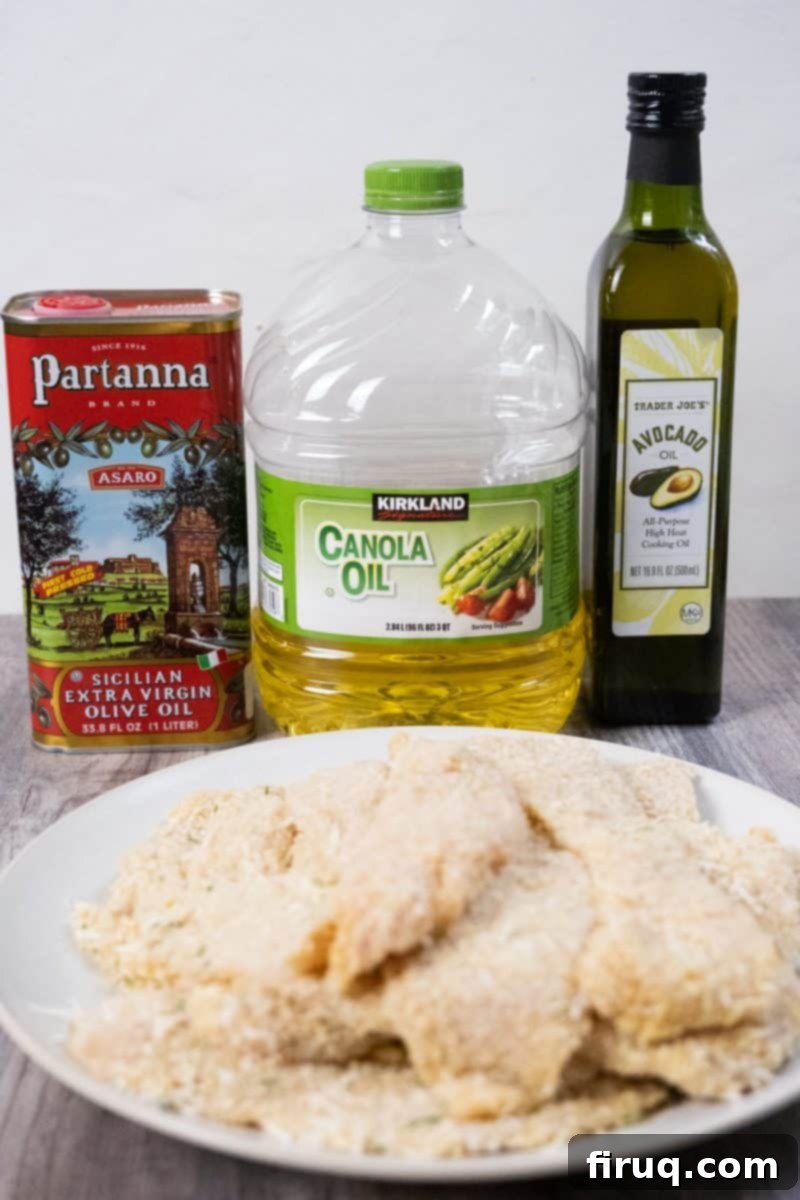
Decoding the Health Benefits of Frying Oils
Before diving into the sensory aspects, let’s explore the nutritional profiles of each oil, as health is a significant factor for many home cooks.
Avocado Oil: A Heart-Healthy Champion
- Avocado oil is renowned for its high content of oleic acid, a monounsaturated fatty acid. This “heart-healthy” fat is known to help reduce inflammation and lower levels of LDL (bad) cholesterol, contributing to better cardiovascular health.
- It naturally contains chlorophyll, a powerful antioxidant and a natural source of magnesium. Chlorophyll is believed to assist in detoxifying the body by helping to remove heavy metals from organs like the brain, liver, and kidneys.
- The abundance of monounsaturated fats in avocado oil also plays a crucial role in enhancing the body’s ability to absorb fat-soluble vitamins (A, D, E, K) from other foods, making your meals even more nutritious.
- Beyond frying, its mild flavor makes it versatile for dressings and marinades, further boosting its appeal as a healthy kitchen staple.
Canola Oil: The Highly Processed Contender
It’s important to approach research on canola oil with a critical eye, as a significant portion is funded or supported by organizations like The Canola Oil Council of Canada and The US Canola Association. This means much of the readily available information might carry a bias towards highlighting its benefits.
Some reported benefits, often found in studies supported by these “Big Canola” entities, include:
- Improved insulin sensitivity and glucose tolerance, potentially beneficial for managing blood sugar.
- Claims of decreased cancer cell growth, though such statements warrant careful scrutiny.
- Increased antioxidant levels.
While these claims exist, I personally remain skeptical of any highly processed product touting “decreased cancer” benefits. It’s challenging to reconcile such assertions with the industrial nature of its production. It just doesn’t quite add up for me, but it’s important to acknowledge the research as presented.
On the flip side, several negatives regarding canola oil are worth considering:
- Most canola oil is extracted using chemical solvents, rather than the more gentle “cold-pressed” method. This chemical processing can destabilize the oil, making it more prone to oxidation and going rancid faster.
- The primary concern with canola oil isn’t necessarily the oil type itself, but its extensive processing. Canola oil is classified as an RBD oil – Refined, Bleached, and Deodorized. This multi-step process aims to create a neutral-tasting, long-shelf-life product, but comes at a cost.
- The refining process can diminish the oil’s natural nutrient content, including beneficial vitamins, antioxidants, and essential fatty acids. While the reduction might be considered minimal by some, it’s an undeniable consequence of the processing. Furthermore, high-heat processing can even create small amounts of unhealthy trans fats.
- Ultimately, the debate around canola oil boils down to one’s comfort level with processed foods. Canola, along with other RBD oils like corn and vegetable oil, undergoes significant industrial processing, which many health-conscious individuals prefer to limit in their diet.
Extra Virgin Olive Oil: A Mediterranean Staple
- Similar to avocado oil, extra virgin olive oil (EVOO) is rich in monounsaturated fats, particularly oleic acid. These fats are well-documented for their ability to help lower harmful cholesterol levels and reduce the risk of heart disease.
- High-quality olive oils, especially those from reputable companies that harvest olives from single origins, tend to have higher concentrations of beneficial compounds like polyphenols. Polyphenols are powerful antioxidants that protect the body from oxidative stress. When purchasing olive oil, look for terms like “single-origin,” “estate bottled,” or “cold-pressed” as indicators of quality and higher nutrient density. Knowing the origin can provide greater insight into its specific nutritional profile.
- EVOO’s robust flavor, which can range from peppery to fruity, also adds a unique depth to dishes, contributing positively to the overall culinary experience.
- However, it’s crucial to differentiate between extra virgin and refined olive oils. Extra virgin is minimally processed, retaining its natural antioxidants and flavor. Refined olive oil, often labeled simply “olive oil” or “light olive oil,” undergoes chemical processing, similar to canola, stripping it of many benefits.
My personal philosophy aligns with the sentiment: “eat food produced by people, not corporations.” While not always feasible in today’s world, prioritizing minimally processed foods is important for my family’s health. Despite the attractive affordability of bulk, highly processed oils like canola, the profound health benefits offered by less-processed options such as avocado and high-quality olive oil often outweigh the perceived conveniences.
A word of caution: even olive oil can be produced on a mass scale with less regard for quality. If you’re buying olive oil in a gallon container, always scrutinize the label to ensure it’s truly extra virgin and from a reputable source, not a blend of refined oils.
The Sensory Experience: Aroma and Visuals During Frying
Beyond health metrics, the immediate sensory experience during frying offers valuable insights. I hadn’t initially planned for “smell” to be a distinct category, but the distinct aromas released as the oils heated up were too noticeable to ignore.
Avocado Oil: A Sweet and Nutty Revelation
Following an alphabetical testing order, avocado oil was first. I’d never fried cutlets with it before, and the initial observation was striking: its smell. As the pan heated, the avocado oil emitted a wonderfully sweet and nutty aroma that was genuinely delightful and a pleasant surprise. Visually, it shimmered perfectly and evenly across the pan, beginning to yellow ever so slightly as it reached temperature. The fragrant, clean scent of the avocado oil truly made it my favorite in this category.
Canola Oil: The Unremarkable Odor
Perhaps it was the stark contrast to the pleasant avocado oil, but the canola oil simply smelled… plain, almost unappealing. The only comparison I could draw was to the generic, somewhat stale scent of a commercial fryer. It certainly lacked the delightful, clean fragrance of the avocado oil, merely smelling like “oil.” This made canola oil my least favorite in terms of aroma. Visually, as it heated and shimmered, it appeared slightly cloudy and didn’t spread as evenly across the pan, suggesting a different consistency or heating pattern.
Olive Oil: Earthy, Fruity, and Refreshing
The extra virgin olive oil offered a distinct and pleasant aroma. It had a slightly fruity or sweet note, perhaps even a hint of tanginess, characteristic of fresh olives. It was a refreshing smell that spoke of quality. While very enjoyable and certainly better than canola, I still found myself preferring the unique nutty sweetness of the avocado oil.
Achieving the Perfect Texture: How Each Oil Performed
When frying chicken cutlets, texture is paramount. We look for an evenly golden, crispy exterior and a juicy, tender interior. This section evaluates how each oil contributed to the cutlets’ final texture and cooking consistency.
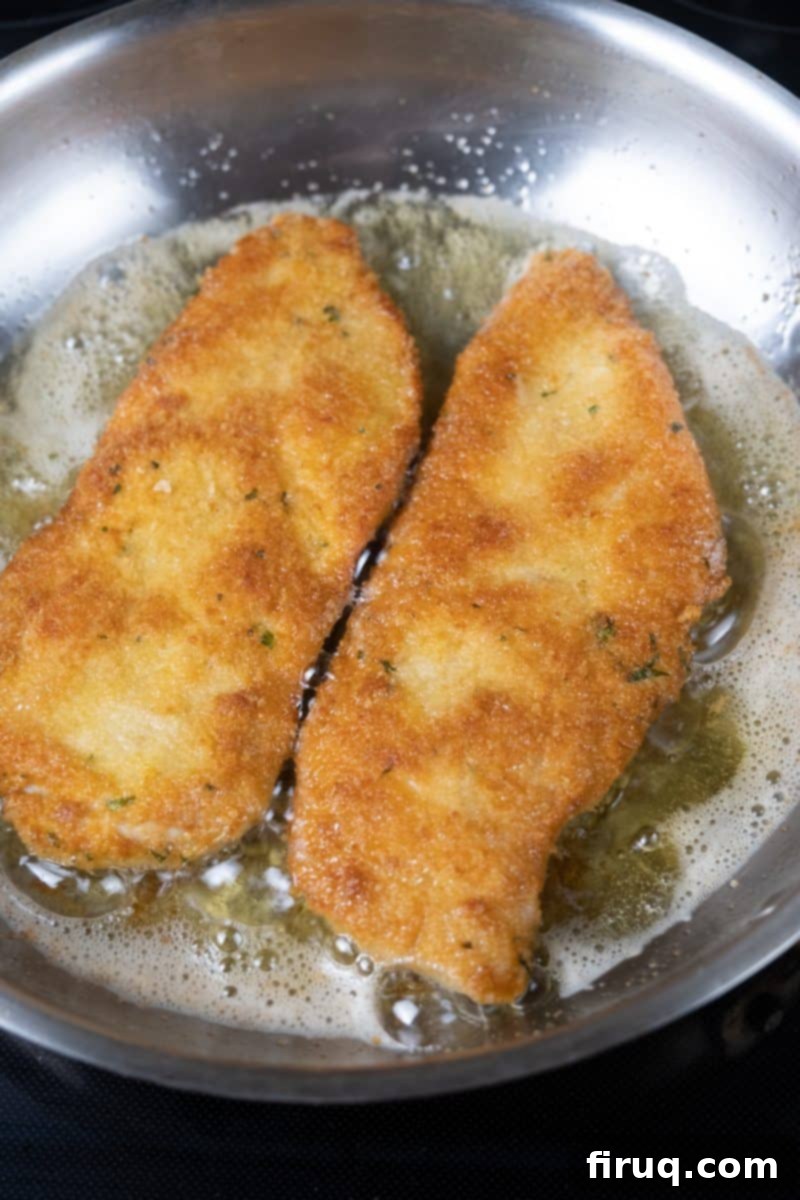
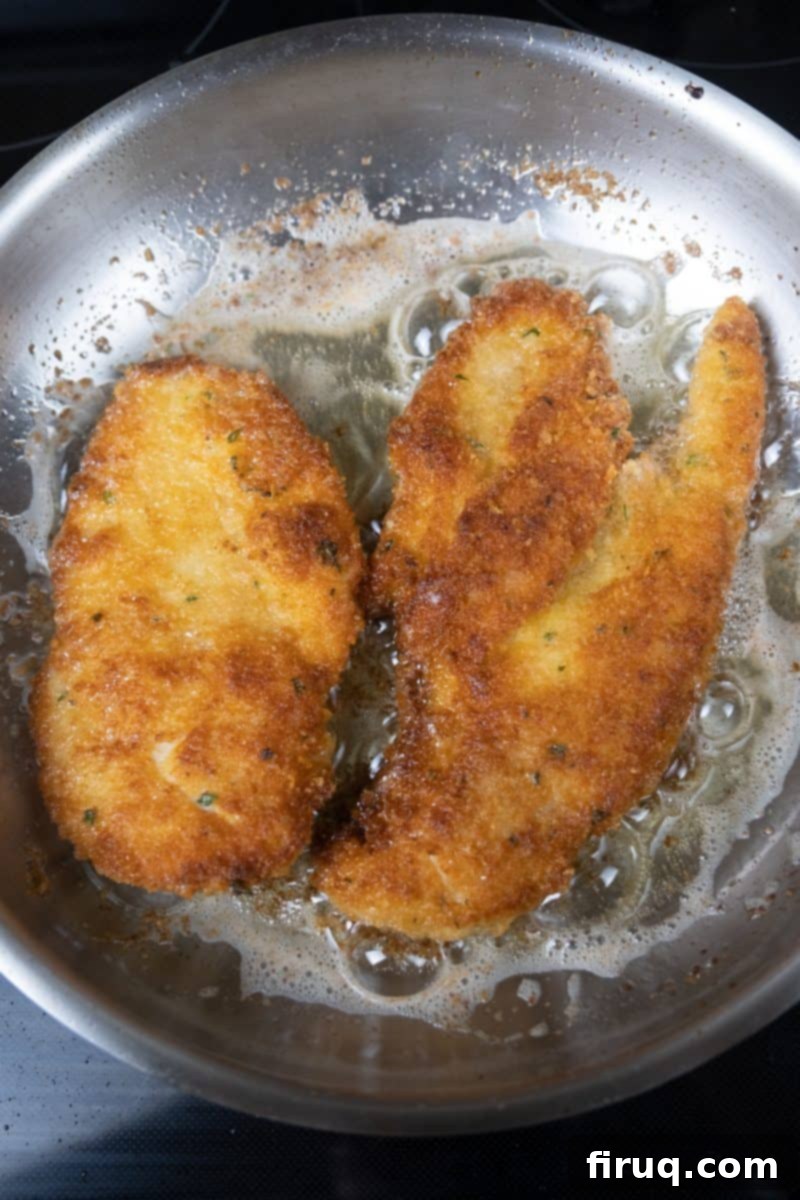
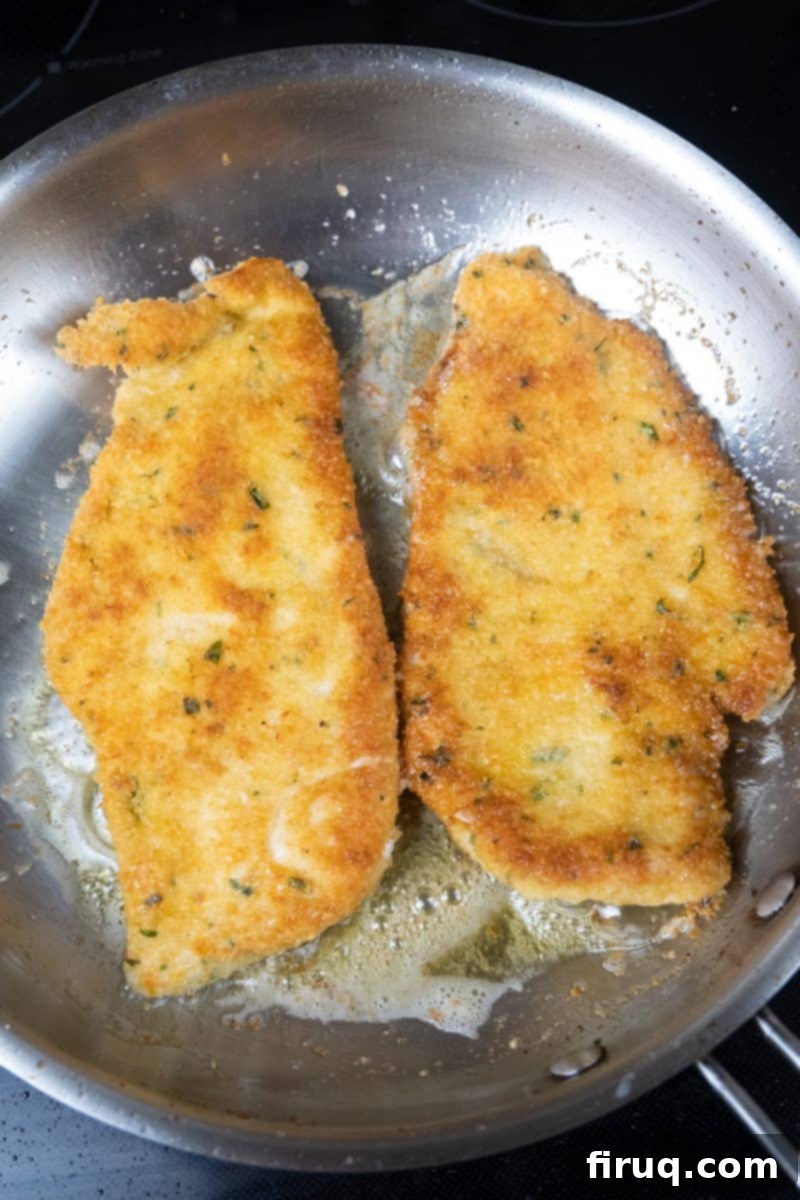
Avocado Oil: The Texture King
Once again, avocado oil emerged victorious in this crucial category. The chicken cutlets fried in avocado oil were cooked to absolute perfection, exhibiting a remarkably even golden-brown crispness across their entire surface. Critically, the interior of the chicken remained incredibly juicy and tender, completely devoid of the “shredded” or dry texture often associated with overcooked poultry. The avocado oil truly facilitated the best overall cooking, resulting in an ideal texture from crust to core.
Canola Oil: Uneven and Chewier
Canola oil placed third in texture. The cutlets fried in canola oil were noticeably unevenly cooked. Some areas were perfectly golden, while others remained lighter, forcing us to slightly overcook parts of the cutlet to achieve an acceptable doneness throughout. This inconsistency in browning meant sacrificing the ideal tenderness in some spots. Furthermore, the internal texture of the canola oil cutlets was slightly chewier compared to those fried in avocado oil, lacking that delicate, melt-in-your-mouth quality.
Olive Oil: A Close Second
The extra virgin olive oil secured a strong second place for texture. While the cutlets weren’t as perfectly even as those from avocado oil, they were remarkably close. The chicken’s internal texture was excellent, mirroring the tenderness achieved with avocado oil. The cutlets were thoroughly cooked, although they could have benefited from slightly darker browning in a few areas to match the visual appeal of the avocado oil version. Overall, a great performance, just a hair shy of perfection.
Flavor Profile: The Subtle Impact of Frying Oil on Taste
While the primary flavor of a chicken cutlet comes from the chicken itself and its breading, the frying oil can subtly influence the overall taste and mouthfeel. This category explores these nuanced flavor differences.
Avocado Oil: Clean and Crisp
Surprisingly, this was the only category where avocado oil didn’t take the top spot. However, its performance was still commendable. The distinct lack of a strong “oil taste” was actually a positive attribute. There was absolutely no oily mouthfeel with the avocado oil cutlets; they simply tasted like perfectly seasoned, salty fried chicken. There was no lingering aftertaste, and they felt notably lighter and less heavy on the palate. While it didn’t add a unique flavor, its neutrality allowed the natural taste of the cutlet to shine through, resulting in a very clean finish.
Canola Oil: Good, but Less Crisp
The cutlets fried in canola oil undeniably tasted good. They had that familiar fried chicken flavor that many are accustomed to. However, they exhibited a slightly heavier mouthfeel compared to the avocado oil cutlets and didn’t retain their crispness quite as well over time, even immediately after cooking. Differentiating the taste among the three oils was genuinely one of the more challenging aspects of the experiment, as a well-cooked chicken cutlet is almost always delicious regardless of the oil. Still, the subtle differences became apparent upon direct comparison.
Olive Oil: A Flavorful Edge
Extra virgin olive oil subtly took the lead in the taste category for me. I detected a delightful hint of the olive oil’s characteristic flavor, which elevated the overall taste experience. I personally adore the nuanced, often fruity and peppery notes of quality olive oil. In these cutlets, it was perfectly balanced – not overpowering, but just enough to add a pleasant, slightly fruity complexity that truly enhanced the chicken. This distinct flavor contribution pushed olive oil to the top for taste.
It’s worth noting that all three cutlets were delicious in their own right; there’s no question about that. However, it required tasting all three side-by-side to truly discern the subtle differences. For future experiments, a double-blind taste test might be beneficial to eliminate any potential bias.
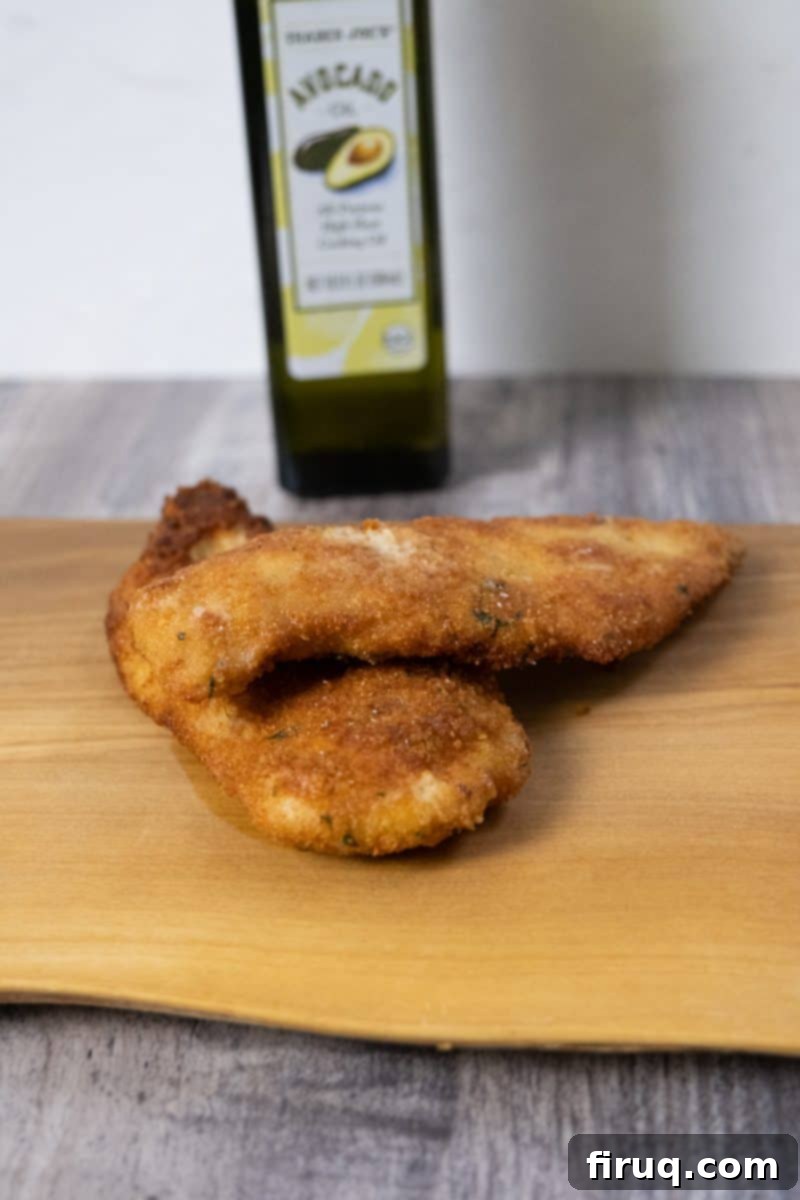
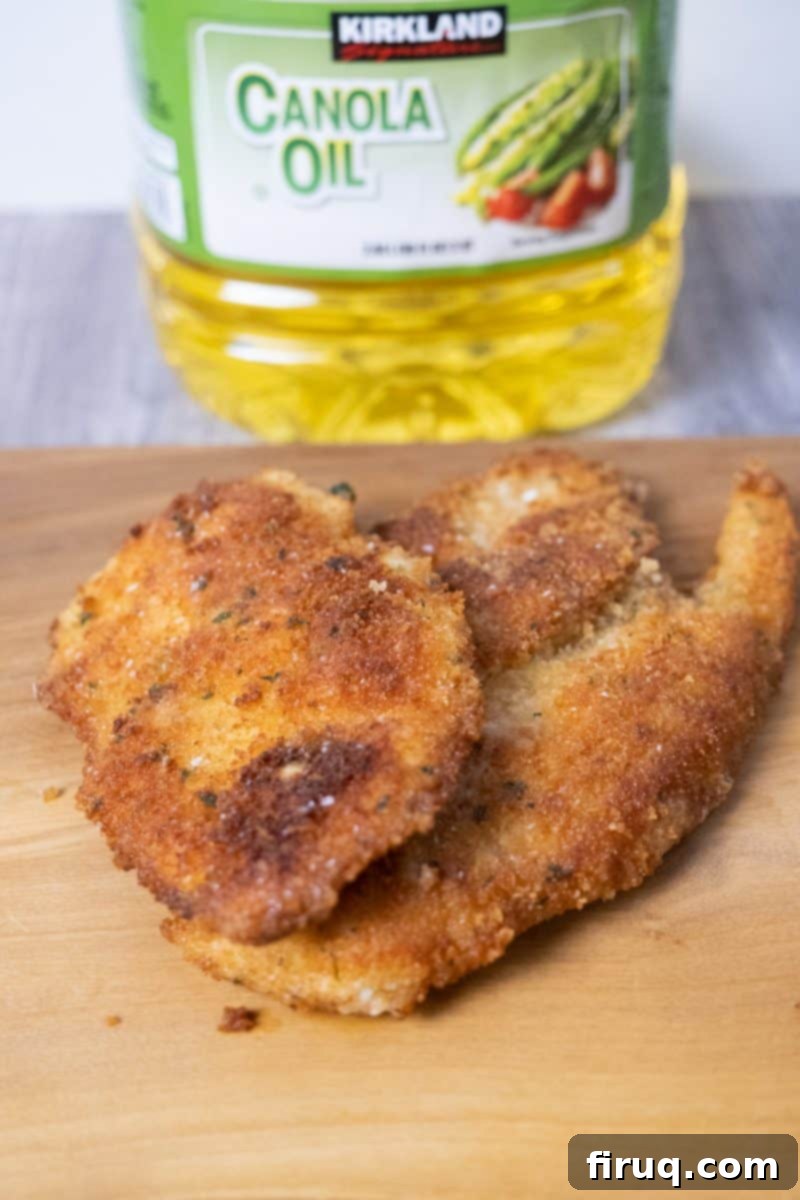
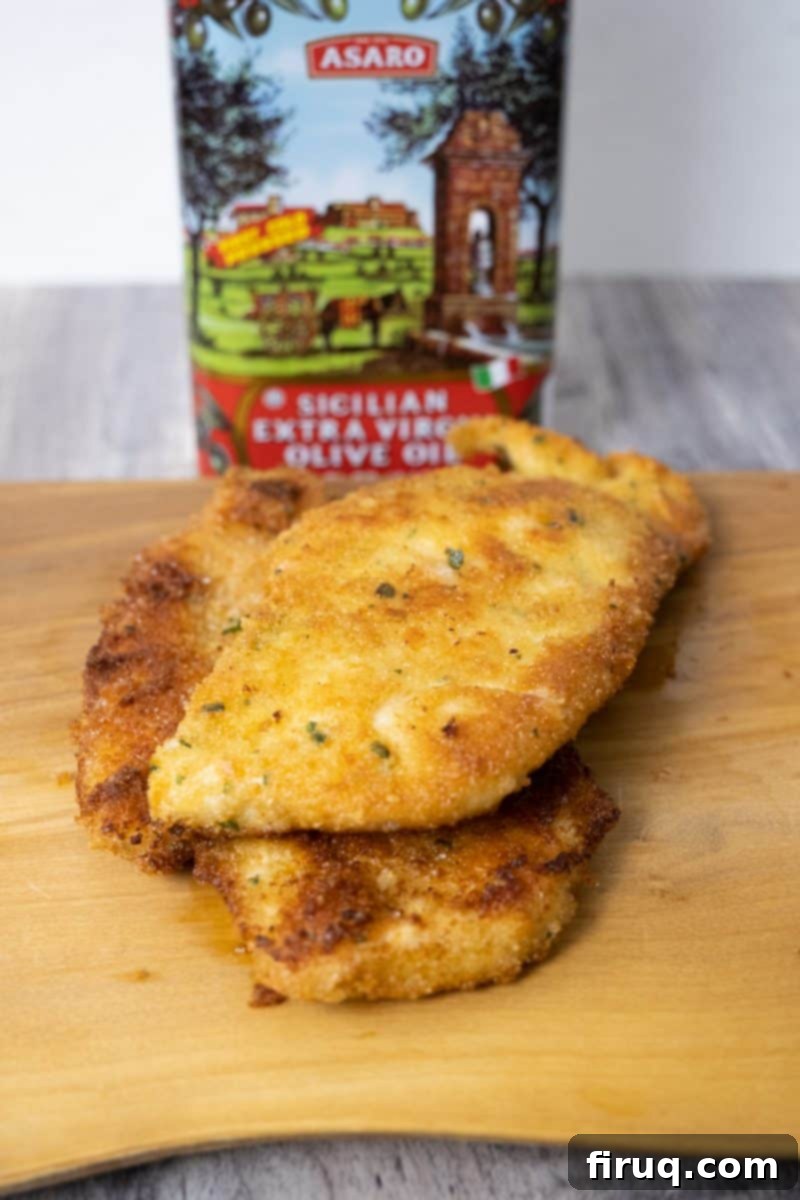
Understanding Smoke Points: A Practical Perspective
One of the most frequently cited arguments in the “what oil to fry chicken cutlets in” debate revolves around smoke points. Many people are quick to dismiss olive oil, particularly extra virgin, due to a perceived low smoke point. This narrative gained traction as avocado oil producers highlighted their product’s higher smoke point as a primary advantage. Let’s look at the average smoke points of our contenders:
- Avocado Oil: Approximately 475℉ (246℃)
- Canola Oil: Approximately 400℉ (204℃)
- Extra Virgin Olive Oil: Approximately 375-400℉ (190-204℃) – *Note: High-quality EVOO can be closer to 400℉, while lower quality or refined olive oils can be higher.*
The crucial point often overlooked is the actual temperature required for pan-frying chicken cutlets. For achieving a perfectly crispy exterior and thoroughly cooked interior, the oil temperature should typically range between 350-400℉ (175-200℃). As you can see, both canola and extra virgin olive oil comfortably fall within this range, provided you maintain proper temperature control.
Therefore, as long as you are mindful of your cooking temperature and avoid overheating the oil, the smoke point argument becomes less critical. Avocado oil does offer a slightly larger buffer if you’re less experienced with temperature management, but it’s not a deal-breaker for using EVOO or canola. Moreover, smoke points can vary depending on the oil’s processing, purity, and even batch. A more stable oil (one less prone to oxidation) can sometimes perform better at high temperatures than an unstable oil with a numerically higher smoke point. Ultimately, I wouldn’t let slight differences in smoke point be the sole determining factor in your choice, focusing instead on overall quality and careful cooking practices.
The Verdict: Which Oil Reigns Supreme for Your Chicken Cutlets?
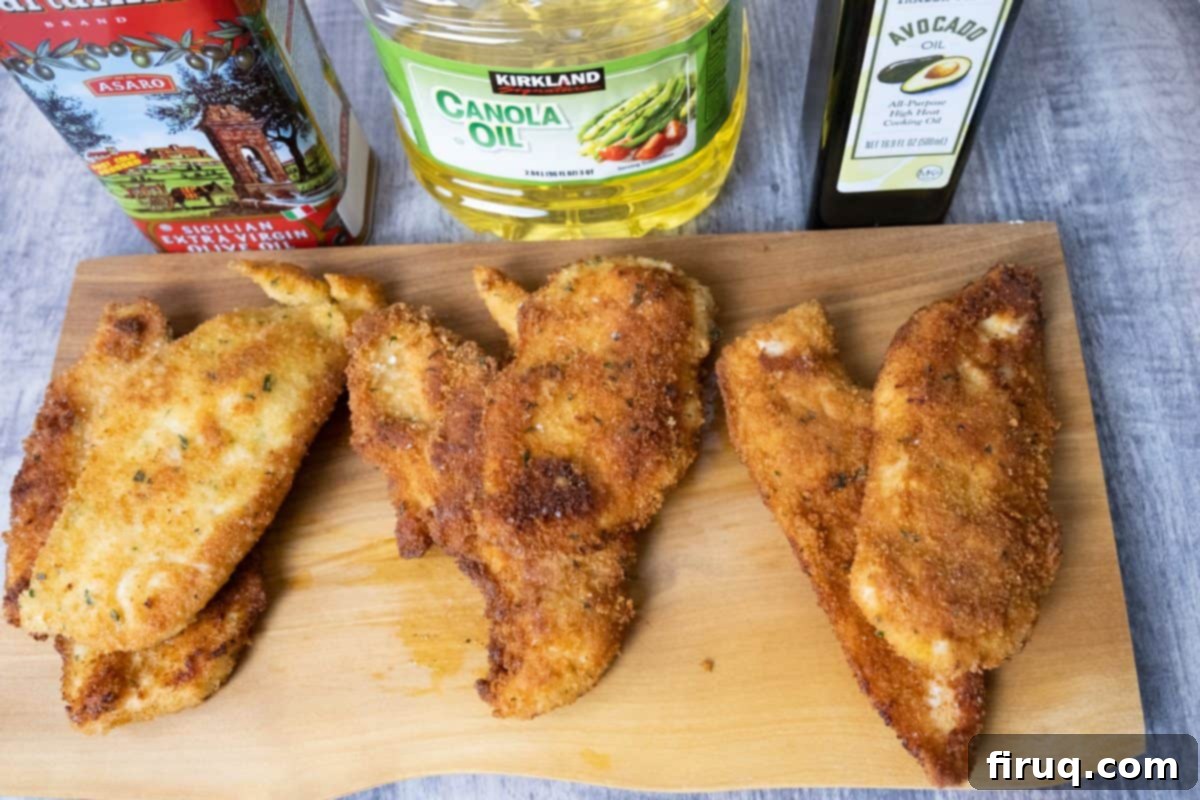
Making a definitive recommendation for the best oil to fry chicken cutlets is, as predicted, a genuinely tough decision given the nuanced results. Avocado oil undeniably delivered the superior texture – consistently even browning and a perfectly tender interior. However, when considering the full spectrum of factors, the compelling health benefits and the subtle, enhancing flavor of high-quality extra virgin olive oil ultimately tip the scales for me.
As someone with Italian roots, there’s a certain culinary heritage that resonates with using olive oil. Moving forward, my preferred choice for frying chicken cutlets will be a high-quality, single-origin extra virgin olive oil. Avocado oil stands as a very close second choice, offering excellent performance and significant health advantages. Conversely, I will be completely phasing out canola oil from my kitchen for frying purposes. The extensive processing and associated negative health factors, as discussed, are too significant to ignore.
Making the Smart Choice for Your Kitchen
Ultimately, the “best” oil for you will depend on your personal priorities. If achieving the absolute crispiest, most evenly cooked texture is your top concern and you prefer a neutral flavor, avocado oil is an outstanding choice. If you prioritize robust flavor, traditional authenticity, and a wealth of antioxidants and heart-healthy fats, then a good quality extra virgin olive oil is likely your winner. For those still considering canola oil, I encourage a deeper look into its processing methods and weigh the convenience against potential long-term health implications.
Regardless of your final decision, remember that high-quality ingredients make a noticeable difference. Investing in well-sourced, less-processed oils can elevate your cooking and contribute to a healthier diet. So, experiment in your own kitchen, taste the difference, and choose the oil that brings you the most joy and confidence in creating the perfect, crispy chicken cutlets every time.
